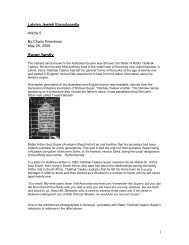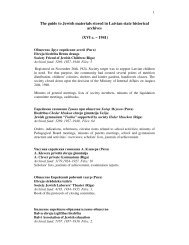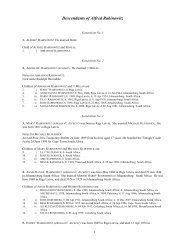Small Riga Ghetto
Small Riga Ghetto
Small Riga Ghetto
Create successful ePaper yourself
Turn your PDF publications into a flip-book with our unique Google optimized e-Paper software.
72<br />
which was in fact our "host". The wages we were supposed to receive from<br />
our employers were paid to the area commissary.<br />
The Labor Authority was set up at 72 Ludzas Street. Its head at that time<br />
was the German Stanke, who had also personally taken part in the liquidation<br />
of the Large <strong>Ghetto</strong>. He was assisted by the Latvian Dralle, whose name will<br />
certainly be known to many <strong>Riga</strong> Jews who used to patronize the Jewish Club.<br />
Dralle's father had been employed there for a long time as a waiter.<br />
Incidentally, now that I am on the subject of the <strong>Riga</strong> club, I do not want to<br />
miss this opportunity to commemorate my good friend Leo Woloschinski. He<br />
was the club's business manager and died a horrible death in July 1941.<br />
The aforementioned Dralle often beat and tortured us. The Jewish leader at<br />
the Labor Authority was a certain Kassel, and he had an assistant named<br />
Maisel (formerly an employee of Louis Thal). The office manager was Mrs.<br />
Wischnewska. Later on we received work booklets, which also served as<br />
passes. These booklets bore the inscription "Jew" in large letters. The employer<br />
had to record in them the hours we had worked.<br />
The outside guard duty was in Latvian hands, but inside the ghetto there was<br />
also a special company of guards (at 66 Ludzas Street). It consisted of German<br />
policemen from Danzig. Initially the chief of this group was the German police<br />
officer Hesfer. Besides him, the murderers Tuchel, Neumann, Kobello, Karasik<br />
and others remain unforgettable to us, for all of them had countless human<br />
lives on their conscience. The reader will hear more details about them soon.<br />
II.<br />
In the beginning, the living conditions in the <strong>Small</strong> <strong>Ghetto</strong> were appalling. Between<br />
ten and fifteen people had to live in one small room. They had to sleep<br />
on the floor, and in addition there was the cold, which we felt very intensely.<br />
Because of the unhygienic conditions all kinds of illnesses due to uncleanliness<br />
naturally spread. The situation in the women's ghetto was exactly the same.<br />
The men's opportunities to visit the women's ghetto were limited; they had<br />
to have special permits to do so. The entrance to the women's ghetto was<br />
guarded initially by Jewish policemen and then by women. At this time the<br />
mood was extraordinarily depressed, for people had lost all trust that they<br />
would be safe in the ghetto, and they began to consider how they could manage<br />
to be transferred to satellite camps in the city. This plotting became a virtual<br />
obsession! (see the chapter "Satellite Camps – <strong>Small</strong> Concentration<br />
Camps"). This obsession led to attempts to escape from the ghetto and from<br />
the work sites. Among those who escaped were Tewje Gurewitsch and his son










